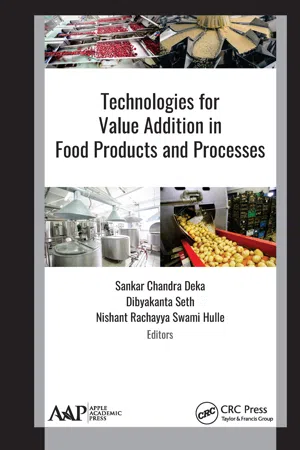
Technologies for Value Addition in Food Products and Processes
- 386 pages
- English
- ePUB (mobile friendly)
- Available on iOS & Android
Technologies for Value Addition in Food Products and Processes
About This Book
The new volume looks at some important emerging food processing technologies in light of the demand for functional food products and high-value and nutritionally rich products. Technologies for Value Addition in Food Products and Processes covers a selection of important recent developments in food processing that work to enrich or maintain nutritional value of food products, including such applications as non-thermal plasma, refractance window drying, extrusion, enzyme immobilization, and dry fractionation.
Dry fractionation, in particular, has emerged as a sustainable alternative to wet processes in last three decades for producing protein concentrates from legumes. Several chapters on fish processing cover both traditional knowledge and advances in fish processing technologies. A chapter on bioethanol production discusses the past and present status of the industry, focusing on economic feasibility and environmental viability. A chapter also discusses traditional fermentation process and nutritional aspects of ethnic foods followed by the Rabha-Hasong, Mishing and Karbi communities of Assam, India.
With the contribution from experts in their respective fields, this volume provides new information on novel food processing technologies.
Frequently asked questions
Information
Chapter 1
Rheology: A Tool to Predict Quality of Foods
1.1 Introduction
- Establishing a relationship between rheological properties and sensory perception;
- Selection of food ingredients for end uses;
- Effect on food quality due to compositional changes;
- Elucidating the textural quality;
- New product development;
- Effect on quality of final food product due to processing.
1.2 Basics of Rheology
Table of contents
- Cover
- Halftitle Page
- Title Page
- Copyright Page
- About the Editors
- Contents
- Contributors
- Abbreviations
- Preface
- 1. Rheology: A Tool to Predict Quality of Foods
- 2. Food Extrusion Technology and Products
- 3. Non-Thermal Plasma (NTP) Applications for Food Decontamination Technology
- 4. Refractance Window Drying and Its Applications in Food Processing
- 5. Enzyme Immobilization in Food and Agriculture: Principles, Practices, and Future Prospects
- 6. Aonla: Composition, Medicinal Properties, Processing, and Food Applications
- 7. Traditional Technology of Fish Preservation in Northeast India
- 8. Advances in Fish Processing Technology
- 9. Nutritional Values and Processing of Tropical Tuber Crops
- 10. Bioethanol Fermentation: The Path Forward for Eco-Friendly and Sustainable Development
- 11. Traditional Fermentation by the Rabha-Hasong, Mishing, and Karbi Communities of Assam and Prospects of Value Addition for Enhancement of Nutritional Qualities in Ethnic Foods
- 12. Rice Protein: Properties, Extraction, and Applications in Food Formulation
- 13. Application of Natural Biopolymer Films as Edible Coatings on Cut Fruits and Vegetables
- 14. Dry Fractionation of Legumes
- Index